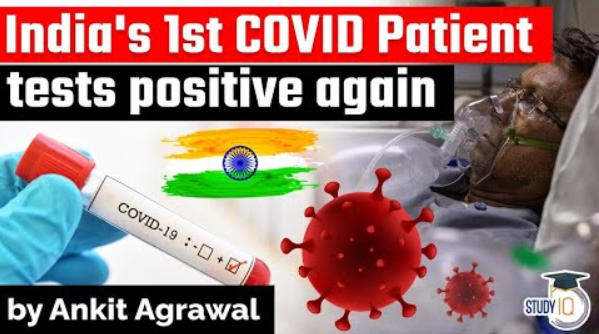Table of Contents

What has happened?
- A woman medico, who was India’s first COVID-19 case, has tested positive again for the virus, health authorities said here on Tuesday.
- “She is reinfected with COVID-19.
- Her RT-PCR is positive, antigen is negative. She is asymptomatic,” Thrissur DMO Dr K J Reena told.
- Her samples were tested as she was prepared to go to New Delhi for study purposes.
- Then the RT-PCR result turned out to be positive, she said.
1st patient in India
- It was on January 30, 2020 that the third year medical student from Wuhan university tested positive for coronavirus,
- Becoming the country’s first COVID-19 patient, days after she had returned home following semester holidays.
- After nearly three weeks of treatment at the Thrissur Medical College Hospital, she had tested negative twice for the virus, confirming her recovery, and was discharged on February 2 , 2020.
Has she received vaccine?
- Officials familiar with the matter also said that the student is yet to receive the first dose of an approved Covid-19
Its significance?
- Reinfection with SARS-CoV2 is the subject of an open scientific discussion. As of now, it is not clear whether a person who has been infected once develops permanent immunity against the disease, or can get reinfected after some time.
- An understanding of the possibility of reinfection is crucial to the fight against the pandemic.
- It will not only help decide the intervention strategies required to control the spread of the disease, but also help assess how long people would have to depend on masks and physical distancing.
- As of now, very few cases of reinfection have been confirmed.
- The first confirmed case was reported from Hong Kong in August last year.
- After that, a couple of cases from the United States and Belgium also.
- There have been several cases of people testing positive for the virus multiple times, even in India, but not all such cases are considered reinfections.
- That is because of what is called “persistent viral shedding”. Recovered patients can sometimes continue to carry low levels of virus within their system for up to 3 months.
- These levels are no longer enough to make the person sick or transmit the disease to others, but it can get detected in diagnostic tests.
How can reinfection be determined?
- For a conclusive proof of reinfection, scientists rely only on genome analysis of the virus sample.
- Because the virus mutates continuously, the genome sequences of the two samples would have some differences.
- However, virus sample from every infected person is not being collected for genome analysis.
- That would be a herculean task, because genome analysis is a complicated procedure and takes time and effort.
- Samples from only a few randomly selected patients are sent for genome analysis to study the nature and behaviour of the virus.
- Therefore, when a person tests positive for a second time, and has to be checked for reinfection, there is usually no genome sequence from the previous infection to compare with.
ICMR study
- In a first-of-its-kind exercise, a team of scientists from the Indian Council of Medical Research (ICMR) has identified a set of most plausible cases of reinfection of SARS-CoV2 virus in India.
- In a study that has been accepted for publication in the journal Epidemiology & Infection,
- The scientists examined the cases of 1,300 individuals who had tested positive for the virus twice, and had undergone tests even between the two positive results.
- The study found that the cases of 58 of the 1,300 individuals, or 4.5%, could actually be classified as possible reinfections.
- In these 58, the two positive results had come at least 102 days apart, and they also had a negative test result in between.
Q) Which of the following is not an RNA virus?
- Retrovirus
- Adenovirus
- Rubellavirus
- None of the above
Latest Burning Issues | Free PDF

























 WhatsApp
WhatsApp